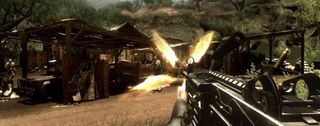FarCry 2 did a lot of bold, weird things.

FarCry 2 did a lot of bold, weird things. It moved the setting from the tropical island of the first game to the African savannah. It introduced "buddies", friendly NPCs who acted as save points and whose survival or death shaped your personal story. It gave the main character malaria, and forced you to travel the world to find medicine.
It's early days for FarCry 3 - there's a lot the presentation I saw didn't show, and a lot the producer I interviewed wouldn't say - but it seems to be walking back from that weirdness, keeping what worked, and re-establishing the things that made the original FarCry feel like such a wonderful holiday.
The presentation opens with the player in a dense jungle, stood alongside a crashed, rusted fighter plane. It's old, and isn't how you got here. You're Jason Brody - your girlfriend is gone, your friends are gone, and you're "off the edge of the map," says Dan Hay, the game's producer
Peering over a nearby ledge, we get our first look at the island laid out before us. There's a small camp not far from here, beyond which spreads blue ocean, blue sky, and more green, jungle-covered mountains. It's beautiful - the primary colours of FarCry 1 made with today's technology and running on a beast of a PC sat under the screen.
In the village below, people are being lined up on their knees by armed men. Brody takes photos for the brief moment before he gets knocked unconscious with the butt of a rifle, and we wake up to this guy staring at us:
This is Vaas. "Did I ever tell you the definition of insanity?" he says. "Doing the exact same thing over and over again, expecting shit to change. That is crazy." He rambles, he's nuts, but he speaks at a reasonable pace. That's an improvement over FarCry 2's hurried acting.
So far, so scripted. It's a few minutes later, when the fighting starts, that it begins to look more like FarCry. There's a jungle, there are patrolling guards and, from the looks of it, there's more than one way to approach the situation. On the far side of the camp in front of us, there's a military helicopter. It's the best way out of here, if the player can reach it.
In the video, the player approaches quietly, using a machete found in a corpse's back. He pounces on an enemy below from a small ledge, and moving between shacks, uses the knife again to stab one guy in the neck and then hurl it into the face of another sitting close by. These are special takedown moves.
The bodies can then be looted for money and guns afterwards - and, we're told, the guns don't decay any more.
"We wanted to make sure we were giving the player the ability to turn on the action when they want to turn on the action," says Hay. "Making sure that the AI isn't always hammering you with bullets." FarCry 2's enemies were so bloodthirsty, they'd smash their cars into trees, leap out and begin firing the second you appeared on the horizon.
The player turns on the action, using an AK-47 to take down three guys in the middle distance, before sprinting and diving into a river. It's beautiful under here. "We wanted to give you that same feeling you had in FarCry 1 the first time you jumped in the water. 'Oh my god, I can't believe how good it looks'". I can believe how good it looks, but it looks very good.
Emerging on the other side, the player pops some explosive barrels foolishly positioned on a wooden bridge, and sprints for the helicopter. It switches back to a scripted scene, thankfully without breaking first-person, and Jason threatens the pilot with a pistol: take off, now. It's 15 seconds before he's shot back down, back face to face again with Vaas.
"Did I ever tell you the definition of insanity?" he says. And scene.
Let's be clear here. A seven-minute presentation of a linear, partly scripted combat bubble isn't the best way to show an open world game. What we saw looked like a first-person shooter - and not just without the boldness of the last game, but without so much of the core of what makes FarCry special.
What we did get were some promising words from Hay; mainly, that exploration will be a big part of the experience. "You're walking along, you're on a mission - maybe you're in a truck, bombing along pretty quick. There's always something just off the edge of the map - 'what is that?' You stop, you get out, you explore. Exploration is key to us."
In the demo, there were little glimpses of things: the downed plane at the start, statue heads buried in the grass, ancient temples spotted through the trees.
There's also more to the game than just Vaas - he's not the big bad, but just one enemy leader. The buddies, too, will return, albeit in changed form. Tim has an interview with the narrative designer later this week which should reveal more.
The biggest question mark, though, is the respawning enemies that made so much of the last game a slog. The question seemed to flummox Hay slightly, which is worrying.
For now, though, I'll give the game the benefit of the doubt. For all the interesting things that made me like FarCry 2, I wouldn't mind another summer holiday in a better, monster-free FarCry 1.
































